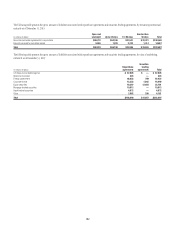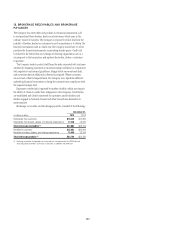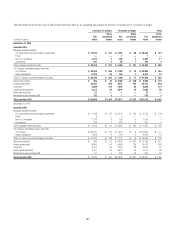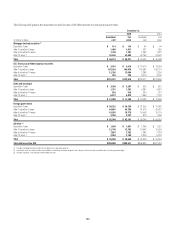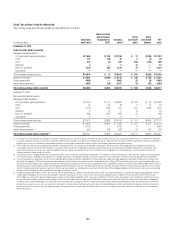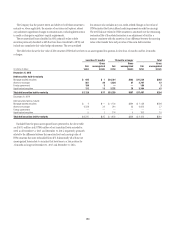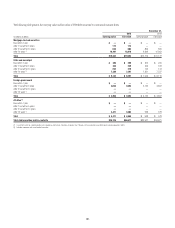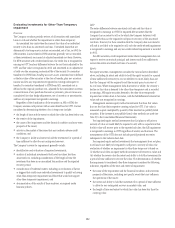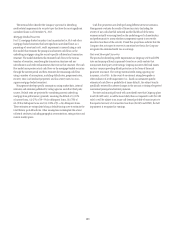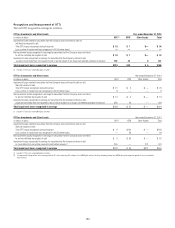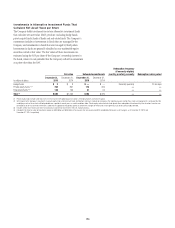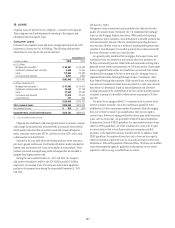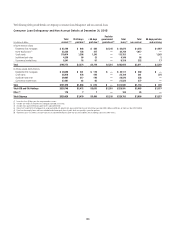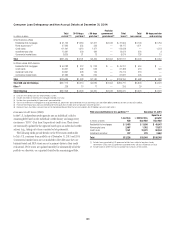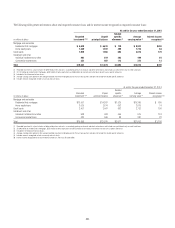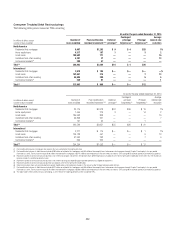Citibank 2015 Annual Report Download - page 210
Download and view the complete annual report
Please find page 210 of the 2015 Citibank annual report below. You can navigate through the pages in the report by either clicking on the pages listed below, or by using the keyword search tool below to find specific information within the annual report.192
Evaluating Investments for Other-Than-Temporary
Impairment
Overview
The Company conducts periodic reviews of all securities with unrealized
losses to evaluate whether the impairment is other-than-temporary.
An unrealized loss exists when the current fair value of an individual
security is less than its amortized cost basis. Unrealized losses that are
determined to be temporary in nature are recorded, net of tax, in AOCI for
AFS securities. Losses related to HTM securities generally are not recorded,
as these investments are carried at adjusted amortized cost basis. However,
for HTM securities with credit-related losses, the credit loss is recognized in
earnings as OTTI and any difference between the cost basis adjusted for the
OTTI and fair value is recognized in AOCI and amortized as an adjustment
of yield over the remaining contractual life of the security. For securities
transferred to HTM from Trading account assets, amortized cost is defined
as the fair value of the securities at the date of transfer, plus any accretion
income and less any impairment recognized in earnings subsequent to
transfer. For securities transferred to HTM from AFS, amortized cost is
defined as the original purchase cost, adjusted for the cumulative accretion
or amortization of any purchase discount or premium, plus or minus any
cumulative fair value hedge adjustments, net of accretion or amortization,
and less any impairment recognized in earnings.
Regardless of the classification of the securities as AFS or HTM, the
Company assesses each position with an unrealized loss for OTTI. Factors
considered in determining whether a loss is temporary include:
• the length of time and the extent to which fair value has been below cost;
• the severity of the impairment;
• the cause of the impairment and the financial condition and near-term
prospects of the issuer;
• activity in the market of the issuer that may indicate adverse credit
conditions; and
• the Company’s ability and intent to hold the investment for a period of
time sufficient to allow for any anticipated recovery.
The Company’s review for impairment generally entails:
• identification and evaluation of impaired investments;
• analysis of individual investments that have fair values less than
amortized cost, including consideration of the length of time the
investment has been in an unrealized loss position and the expected
recovery period;
• consideration of evidential matter, including an evaluation of factors
or triggers that could cause individual investments to qualify as having
other-than-temporary impairment and those that would not support
other-than-temporary impairment; and
• documentation of the results of these analyses, as required under
business policies.
Debt
The entire difference between amortized cost basis and fair value is
recognized in earnings as OTTI for impaired debt securities that the
Company has an intent to sell or for which the Company believes it will
more-likely-than-not be required to sell prior to recovery of the amortized
cost basis. However, for those securities that the Company does not intend to
sell and is not likely to be required to sell, only the credit-related impairment
is recognized in earnings and any non-credit-related impairment is recorded
in AOCI.
For debt securities, credit impairment exists where management does not
expect to receive contractual principal and interest cash flows sufficient to
recover the entire amortized cost basis of a security.
Equity
For equity securities, management considers the various factors described
above, including its intent and ability to hold the equity security for a period
of time sufficient for recovery to cost or whether it is more-likely-than-not
that the Company will be required to sell the security prior to recovery of
its cost basis. Where management lacks that intent or ability, the security’s
decline in fair value is deemed to be other-than-temporary and is recorded
in earnings. AFS equity securities deemed to be other-than-temporarily
impaired are written down to fair value, with the full difference between fair
value and cost recognized in earnings.
Management assesses equity method investments that have fair values
that are less than their respective carrying values for OTTI. Fair value is
measured as price multiplied by quantity if the investee has publicly listed
securities. If the investee is not publicly listed, other methods are used (see
Note 25 to the Consolidated Financial Statements).
For impaired equity method investments that Citi plans to sell prior to
recovery of value or would likely be required to sell, with no expectation that
the fair value will recover prior to the expected sale date, the full impairment
is recognized in earnings as OTTI regardless of severity and duration. The
measurement of the OTTI does not include partial projected recoveries
subsequent to the balance sheet date.
For impaired equity method investments that management does not plan
to sell and is not likely to be required to sell prior to recovery of value, the
evaluation of whether an impairment is other-than-temporary is based on
(i) whether and when an equity method investment will recover in value and
(ii) whether the investor has the intent and ability to hold that investment for
a period of time sufficient to recover the value. The determination of whether
the impairment is considered other-than-temporary considers the following
indicators, regardless of the time and extent of impairment:
• the cause of the impairment and the financial condition and near-term
prospects of the issuer, including any specific events that may influence
the operations of the issuer;
• the intent and ability to hold the investment for a period of time sufficient
to allow for any anticipated recovery in market value; and
• the length of time and extent to which fair value has been less than the
carrying value.


